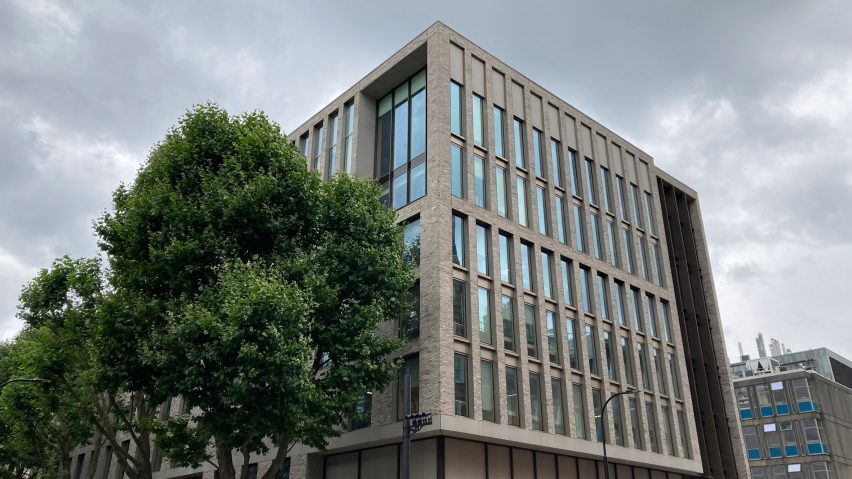The culture of bullying, harassment, racism and sexual misconduct by staff at Bartlett School of Architecture exposed in a report published yesterday comes as no surprise and happens in many other schools, according to architects who have commented on social media.
"No surprises about toxic culture at the Bartlett," tweeted Invisible Studio founder Piers Taylor, a former Bartlett student and one of many architects to take to social media to comment on the report.
"The most unpleasant crit I've ever been in was at the Bartlett," he added.
The report, which identified a culture of bullying, harassment, racism and sexual misconduct by staff, "is both shocking and completely unsurprising," according to architect Alison Killing.
"Disgusting that this behaviour has been allowed to go on so long and that it was so widely known about," tweeted Killing, who won the Pulitzer Prize for exposing Chinese internment camps.
Published yesterday by legal consultancy Howlett Brown, the report found a "toxic learning and teaching culture" had been in place for decades at the school, which is part of University College London (UCL).
More than 300 students and staff were interviewed for the investigation that informed the report. Today it emerged that Bartlett director Bob Sheil resigned ahead of the report's publication.
Sheil was already set to be replaced in September by the recently appointed professor Amy Kulper, following the school's search for a "transformative leader".
Students experienced sexism, racism and bullying
"I witnessed and experienced sexism, racism, antisemitism and bullying, said Public Practice co-founder Pooja Agrawal.
"Ten years on, the toxicity of this school impacts loved ones and me," she wrote on Twitter. "I encourage others to formally share their experiences. Let that 300 become 3,000 voices."
The Bartlett is regarded as one of the best architecture schools in the world and currently ranks first in the UK for architecture, according to the QS World Rankings.
Reputation for "abusive practice" spans decades
A statement issued by UCL includes a comment from its president Michael Spence who said he was "deeply shocked" by the report's findings.
However, the "UCL president appears to be the only person" shocked by the scandal, according to Barton Architects founder Lewis Barton.
"UCL president appears to be the only person in either academia or architecture who is shocked by these revelations," Barton wrote.
"The Bartlett has had a reputation for abusive practice (or is that academic excellence?) for decades."
White Arkitekter architect Eva Datta said "all of this was happening" while she was a student 17 years ago.
"I found it really strange that UCL didn't act at the time (bc even then, bullying had gone on for decades)," she reflected on Twitter.
Among the findings in the report was that a senior leader had been flagged by 27 interviewees for their misogynistic and anti-semitic behaviour.
"It happened again, and again, and again, at least twenty-seven times," said The Developer's editor-in-chief Christine Murray. "They knew."
"These issues are not unique to the Bartlett"
Many of those who have reacted to the report on Twitter believe that the issues identified at the Bartlett are widespread in UK architecture education.
"Glad to see that UCL is finally waking up to this 30+ year problem," wrote architecture and design critic Olly Wainwright.
"But these issues are not unique to the Bartlett – the findings of this report apply to so many architecture schools."
Architect Douglas Murphy shared a similar view, stating that "most of the behaviours described are things that can been found throughout architectural academia", while campaign platform Future Architects Front (FAF) said that the report "represents a pattern of abuse from across all of architectural education".
"This moment must act as a powerful precedent for how students and alumni can organise in order to demand justice," FAF shared on Twitter.
This claim was backed by architects Sean Griffiths and Dinah Bornat, who are among those who believe in the toxic culture that runs throughout the architecture industry.
Bornat said she "left teaching for reasons I can't go into" but that the report's findings "could equally apply" to the school in which she taught.
Griffiths said this was "only the most intense example of what has long been a toxic culture in architectural education".
"I was told b4 I started to expect to stay up all night & be humiliated the next morning at the crit & I was only going to Manchester Poly!" he added.
"Serious reflection at RIBA" required
The investigation has also led some industry figures to question the lack of response by the Royal Institute of British Architects (RIBA).
"Where is the RIBA response to the Bartlett report?" asked Laura Marks.
"Accreditation should look at not just what is being taught in the schools but the environment in which it is being taught," she continued. "By accrediting schools with widespread issues it enables these problems to carry on and endorses them."
In response, designer Adam Nathaniel Furman wrote: "There needs to be some serious reflection at RIBA with regards to how consistently celebrated the Bartlett, and Bartlett-lite schools have been over the past few decades".
The main photo is by Elsa Richmond Seaton.

